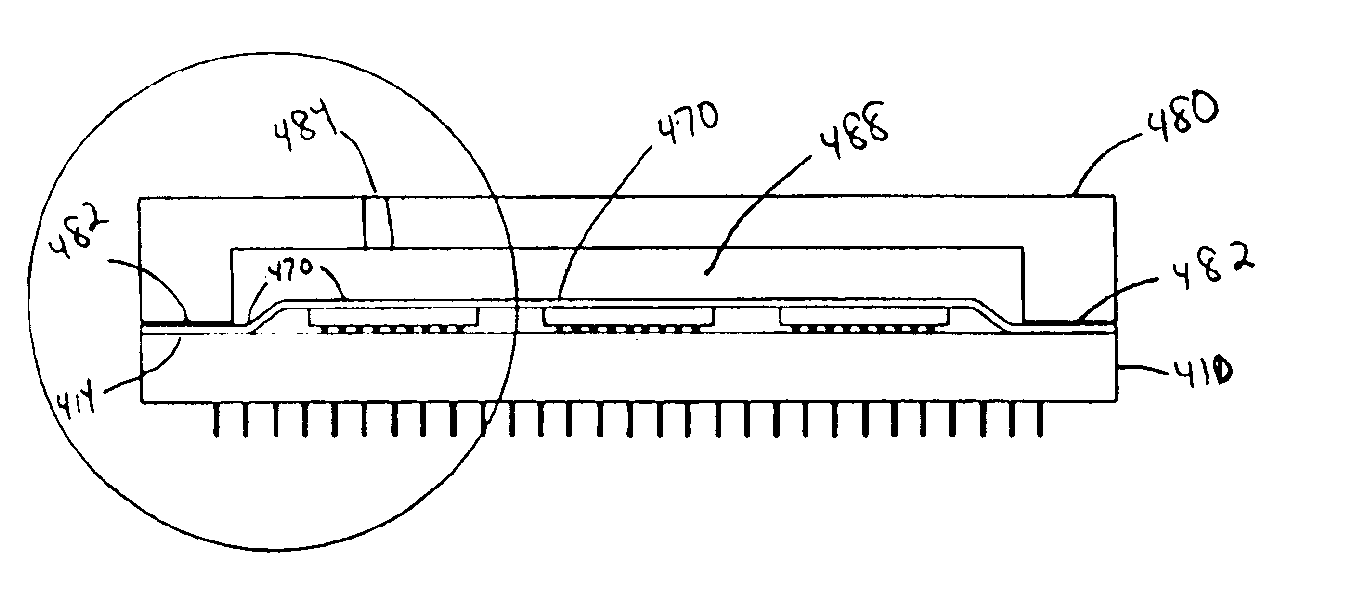Electronic device substrate assembly with multilayer impermeable barrier and method of making
a technology of electronic devices and substrates, applied in the direction of electrical apparatus casings/cabinets/drawers, lighting and heating apparatus, instruments, etc., can solve the problems of increasing device temperature, power dissipation, and therefore heat production, and achieve the effect of high effective thermal conductivity path
- Summary
- Abstract
- Description
- Claims
- Application Information
AI Technical Summary
Benefits of technology
Problems solved by technology
Method used
Image
Examples
embodiment 760
[0043]FIG. 1B further illustrates the multilayer passivation structure of the present invention. A first passivation layer 160 substantially occupies the volume adjacent to device assemblies 130, within the area bounded by substrate perimeter area 114, and extending vertically from substrate upper surface 112 to approximately the height of device assembly upper surface 134. As illustrated in FIG. 1B, first passivation layer 160 need not occupy the volume between devices 132 and substrate upper surface 112. First passivation layer 160 may, however, optionally occupy the volume between electronic device 132 and substrate upper surface 112, thereby substantially surrounding connections 136 (see first passivation layer embodiment 760, illustrated in FIG. 7C). A second passivation layer 170 is located above the first passivation layer and above the device assembly upper surfaces 134. Second passivation layer 170 is in contact with device upper surfaces 134, and thermally coupled thereto....
third embodiment
[0062]A variety of process embodiments may be used to apply the first passivation layer, and to expose the device assembly upper surfaces, in keeping with the spirit and scope of the present invention. Three exemplary embodiments are described in detail herein; a summary of these exemplary embodiments is now provided. Other process embodiments are envisioned, within the spirit and scope of the present invention, and are considered part of the invention. One exemplary embodiment involves the application of a uniform or conformal first passivation layer over a substrate subassembly, followed by selective removal of portions of the first passivation layer, thereby exposing device assembly upper surfaces. A second exemplary embodiment involves a selective application of a first passivation layer around the device assemblies and covering passive devices, while leaving device assemblies exposed. An optional uniform exposure step follows, to insure full exposure of device assembly upper su...
PUM
 Login to View More
Login to View More Abstract
Description
Claims
Application Information
 Login to View More
Login to View More - R&D
- Intellectual Property
- Life Sciences
- Materials
- Tech Scout
- Unparalleled Data Quality
- Higher Quality Content
- 60% Fewer Hallucinations
Browse by: Latest US Patents, China's latest patents, Technical Efficacy Thesaurus, Application Domain, Technology Topic, Popular Technical Reports.
© 2025 PatSnap. All rights reserved.Legal|Privacy policy|Modern Slavery Act Transparency Statement|Sitemap|About US| Contact US: help@patsnap.com



